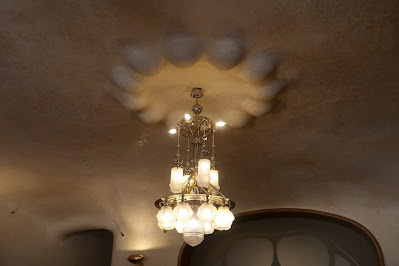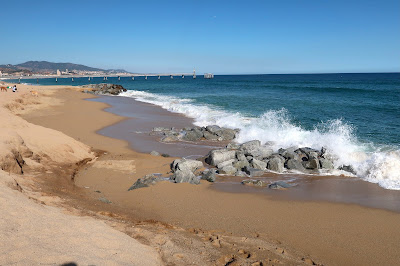After visiting the National Museum in Barcelona, I was eager to be outdoors again, despite the wind and chill that permeated the late winter day.
The panoramic view of the city just outside the doors of the museum was certainly breathtaking, but unfortunately, the lack of green space in the city irritated almost every one of my tree hugger nerves:
A little footnote from tree hugger land -- the World Health Organization recommends that in any city, every residence should be 300 meters or less from an urban park. In Barcelona proper, only 33% of residences have such access to green spaces. While it is easy to think that plentiful green space is a nicety for the outdoorsy types of the world (good for the mood but little else), green space is necessary to avoid the heat island effect that has cities warming much more rapidly than rural areas and bringing various miseries and climate instabilities with it.
But, I digress.
The National Museum sits near the foot of Montjuic (meaning "Jewish mountain" because it houses the remains of a medieval Jewish cemetery) which Wikipedia tells me is "... a broad shallow hill with a relatively flat top overlooking the harbour, to the southwest of the city centre." Buying into the idea that Montjuic was merely a hill and not a mountain of any sort, I ventured uphill and after a few twists and turns that left me little idea how to get back to where I started, I encountered stairs. Curious to see the flat top and the Castle of Montjuic that stands upon it, I started climbing up stairs set into the shallow side of the hill. I thought that surely a hill of a mere 184 meters could not host very many stairs. I would be at the summit in no time, enjoy the view of the harbour from the steep side of Montjuic and then amble back down, to reconnect with my traveling companion and friend. Right?
Wrong.
As with all hikes headed toward a summit or a view, there comes a point when a paricularly stubborn form of stubbornness sets in and no way would I give up and turn back before reaching the top. Those wicked stairs ...they just seemed to keep on going and going and going. So much so, that when I finally caught my breath and descended along those very same steps (much to the dismay of my aging knees), I counted them to see if my breathlessness at the top was just about age or something else.
By my total count, plus or minus a few steps here and there, I had ascended over 500 stair steps. Just a few more and I would have simulated a visit to the Eiffel Tower with the 674 steps it allows tourists to climb according to their preference.
The view at the top of Montjuic was breathtaking but also left little doubt about why this particular location was chosen to defend the city over countless centuries of the past:
By the time I reached the bottom of the hill again (which took far longer than I thought thanks to my talent for wandering and getting lost), my feet and knees were telling me that perhaps I should have opted for the cable car route up the hill.
I ignored them, of course.





































